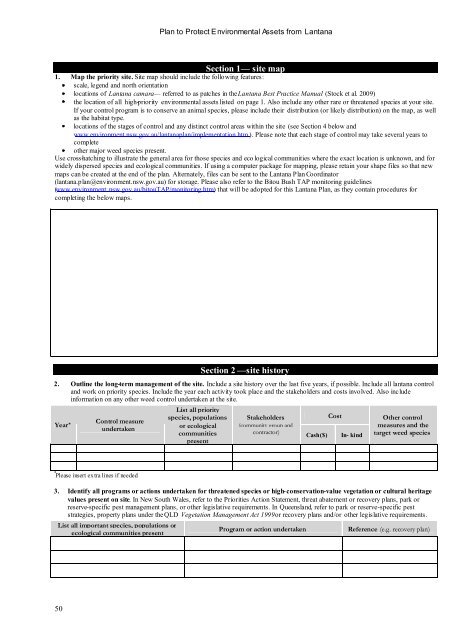Plan to Protect Environmental Assets from Lantana - Weeds Australia
Plan to Protect Environmental Assets from Lantana - Weeds Australia
Plan to Protect Environmental Assets from Lantana - Weeds Australia
You also want an ePaper? Increase the reach of your titles
YUMPU automatically turns print PDFs into web optimized ePapers that Google loves.
<strong>Plan</strong> <strong>to</strong> <strong>Protect</strong> <strong>Environmental</strong> <strong>Assets</strong> <strong>from</strong> <strong>Lantana</strong><br />
Section 1— site map<br />
1. Map the priority site. Site map should include the following features:<br />
scale, legend and north orientation<br />
locations of <strong>Lantana</strong> camara— referred <strong>to</strong> as patches in the<strong>Lantana</strong> Best Practice Manual (S<strong>to</strong>ck et al. 2009)<br />
the location of all high-priority environmental assets listed on page 1. Also include any other rare or threatened species at your site.<br />
If your control program is <strong>to</strong> conserve an animal species, please include their distribution (or likely distribution) on the map, as well<br />
as the habitat type.<br />
locations of the stages of control and any distinct control areas within the site (see Section 4 below and<br />
www.environment.nsw.gov.au/lantanaplan/implementation.htm ). Please note that each stage of control may take several years <strong>to</strong><br />
complete<br />
other major weed species present.<br />
Use cross-hatching <strong>to</strong> illustrate the general area for those species and eco logical communities where the exact location is unknown, and for<br />
widely dispersed species and ecological communities. If using a computer package for mapping, please retain your shape files so that new<br />
maps can be created at the end of the plan. Alternately, files can be sent <strong>to</strong> the <strong>Lantana</strong> <strong>Plan</strong> Coordina<strong>to</strong>r<br />
(lantana.plan@environment.nsw.gov.au) for s<strong>to</strong>rage. Please also refer <strong>to</strong> the Bi<strong>to</strong>u Bush TAP moni<strong>to</strong>ring guidelines<br />
(www.environment .nsw.gov.au/bi<strong>to</strong>uTAP/moni<strong>to</strong>ring.htm) that will be adopted for this <strong>Lantana</strong> <strong>Plan</strong>, as they contain procedures for<br />
completing the below maps.<br />
Section 2 —site his<strong>to</strong>ry<br />
2. Outline the long-term management of the site. Include a site his<strong>to</strong>ry over the last five years, if possible. Include all lantana control<br />
and work on priority species. Include the year each activity <strong>to</strong>ok place and the stakeholders and costs involved. Also include<br />
information on any other weed control undertaken at the site.<br />
Year *<br />
Control measure<br />
undertaken<br />
List all priority<br />
species, populations<br />
or ecological<br />
communities<br />
present<br />
Stakeholders<br />
(community group and<br />
contrac<strong>to</strong>r)<br />
Cash($)<br />
Cost<br />
In- kind<br />
Other control<br />
measures and the<br />
target weed species<br />
* Please insert extra lines if needed<br />
3. Identify all programs or actions undertaken for threatened species or high-conservation-value vegetation or cultural heritage<br />
values present on site. In New South Wales, refer <strong>to</strong> the Priorities Action Statement, threat abatement or recovery plans, park or<br />
reserve-specific pest management plans, or other legislative requirements. In Queensland, refer <strong>to</strong> park or reserve-specific pest<br />
strategies, property plans under theQLD Vegetation Management Act 1999or recovery plans and/or other legislative requirements.<br />
List all important species, populations or<br />
ecological communities present<br />
Program or action undertaken<br />
Reference (e.g. recovery plan)<br />
50

















